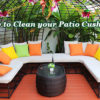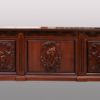When you think of it, furniture defines the style and character of a home more than any other element of the home décor. Without a doubt, every single piece you have chosen to use in your rooms and in your outdoor area not only suits your needs and aesthetic preferences quite well, but also perfectly reflects your personality. Therefore, it is your cherished furniture that makes your home design so cozy, comfortable, and distinctively unique. What’s more, it is a long-term investment that greatly enhances the overall value and appeal of your property.
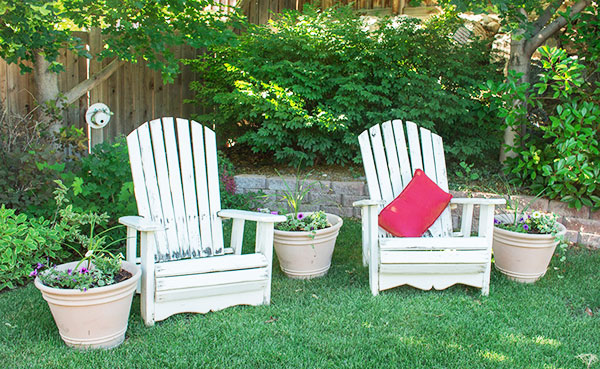
Have you ever wondered if your furniture can get a suntan?
Like any other valuable investment, however, furniture needs to be carefully protected. It’s quite durable and can last for a long time when properly taken care of, but the weather will be taking its toll with every passing year. Large temperature fluctuations, high humidity, intense sunlight, and other harsh atmospheric conditions will slowly but surely damage your furniture. So, to ensure the long life of your cherished pieces and preserve their initial beauty, you need to find an efficient way to protect them from the elements.
How to Protect Outdoor Furniture from the Weather
Patio and garden furniture sits outside most of the year, so it is particularly vulnerable to the weather. To prevent damage and minimize the negative effect of the elements, you need to take adequate precautions and prepare your outdoor furniture for the specific weather conditions in your area. If you live in a hot and dry climate, for example, you may want to paint your furniture to protect it from the sun. But if your home is in a tropical area, you will probably consider applying a water sealant instead. So, make sure you provide the kind of protection your furniture will actually need.
How to Protect Outdoor Wood Furniture from the Elements
Raw, untreated wood cannot survive the harsh weather conditions outdoors for long – it requires some type of coating to protect it from heat and moisture:
- Paint – Paint will provide the best possible protection for your wooden pieces. It reflects the UV radiation from the sun and prevents moisture from seeping into the wood and causing it to rot. Latex paint is your best choice due to its durability, versatility, and ease of application. Besides, it’s available in a great variety of colors, so you will be able to create the aesthetic look that pleases you the most. Depending on the type of your furniture and the specifics of the weather in your area, you will have to reapply the paint every once in a while (whenever you notice fading, chipping, or peeling);
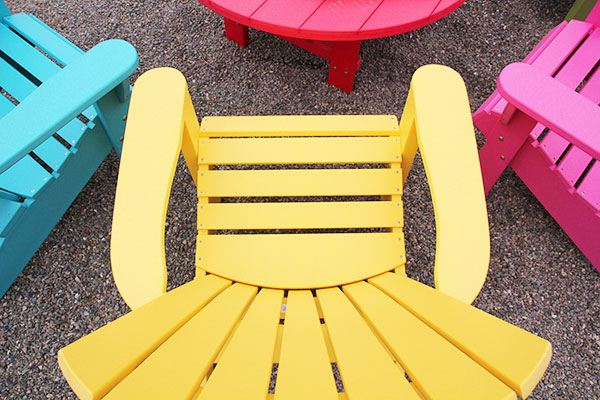
Painting your outdoor furniture will not only provide adequate protection against the elements but will also add extra cheer to your patio or garden!
- Varnish – Unlike paint, varnish allows you to preserve the original look of the wood. It is not as efficient as paint, but it will also successfully protect your furniture from UV light damage, while sealing the wood fibers from water penetration. Just make sure you reapply a coat of varnish every few years to maintain its strength. Have in mind that different types of varnishes have different characteristics, so be careful to choose the one that best suits your particular needs;
- Water sealers and stains – In case you live in an area with high humidity levels or plenty of rainfall, you’re going to need a water sealant or waterproofing stain to effectively protect your outdoor wood furniture from the excess moisture. Water sealers not only prevent water from soaking into your furniture, but also facilitate the natural evaporation of moisture from within the wood, thus reducing the risk of warping, splitting, and rotting. Waterproof stains and water repellents should be reapplied every 2-3 years for maximum efficiency.
If you have wicker furniture consider oiling it to ensure proper protection against the elements. Have in mind that if wicker gets damp, the fibers will soften and stretch and the furniture won’t be safe to use anymore. Applying oil will help you prevent such problems as it makes wicker furniture resistant to water. Remember that oil should be applied twice a year – when the furniture is first taken outside and before it is stored away for the winter.
Excessive heat and moisture may cause the wood to crack and split, while intense sunlight can fade the finishes and break down paint and varnish. If your wood furniture is not properly protected, it will be vulnerable to the weather and may sustain severe damage. In such cases, you will need professional help. The experienced furniture refinishers will be able to restore your wooden pieces’ original beauty or give them an entirely new look according to your preferences.
How to Protect Outdoor Metal Furniture
Unlike wood, metal furniture resists sun damage quite well. Yet, it is very susceptible to rust, so you need to provide your metal pieces with efficient protection from rain and moisture.
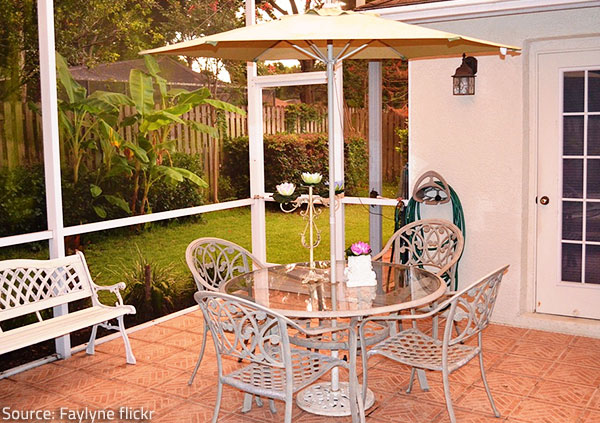
Make every effort to prevent moisture from getting to your metal furniture pieces as they are very susceptible to rust.
You may want to consider having them coated with car wax so that rainwater beads over the surface and doesn’t soak into the metal – this will greatly reduce corrosion. If you notice a rust spot, address it without delay or call a professional furniture refinisher to take care of the problem before the damage has become too extensive.
It is also a good idea to apply outdoor furniture protector directly to the furniture’s frame in order to minimize the impact of heat and UV radiation. Make sure you are in a well-ventilated area when applying the protector and don’t forget to put on rubber gloves and a mask for extra safety.
How to Protect Fabrics
Most fabrics are highly susceptible to fading from the sun and can develop a musty smell and/or mildew if they get damp. When choosing fabrics for your patio or garden, have in mind that materials blended with acrylic, polyester, and nylon are generally less likely to fade than high-end fabrics (such as linen and silk). Remember that dark colors will fade much more quickly than lighter ones.
To protect outdoor fabric furniture from the elements, you are recommended to spray the pieces with a specialized fabric protector (try the product on a small inconspicuous area first to see if it will not damage or discolor your furniture). Reapply the fabric protector at the start of every season to keep upholstery damage to a minimum.
You are strongly advised to store cushions or pillows inside when they are not in use and to collapse your patio umbrella at the end of the day.
Bonus Tips for Protecting Outdoor Furniture
1) Make sure your furniture pieces are clean and dry before applying any kind of protective coating (dirt, dust, and/or moisture will considerably reduce the effectiveness of protection);
2) If possible, place your outdoor furniture in shady and sheltered areas to limit weather damage as much as possible. If you have your pieces on the edges of your patio, for example, sun and rain will affect it more easily. So, it is a good idea to place your furniture at the center of the patio in order to keep it away from the harsh elements, especially on very hot and sunny days or when a storm is coming;
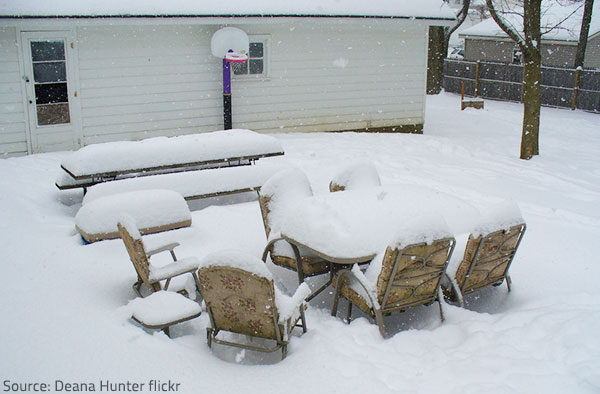
Your outdoor furniture has a very slim chance to survive the harsh winter weather intact.
3) Cover your outdoor furniture when you are not using it. Vinyl furniture covers and tarpaulin provide the best possible protection against the elements. You can also use old sheets or quilts, of course, but they will not keep your furniture safe from moisture. Make sure you take accurate measures in order to get the right sizes and shapes of covers for your specific furniture;
4) To prevent extensive weathering and staining, you are recommended to store your outdoor furniture in a garage or shed during the winter months or in the events of heavy and continuous rain.
How to Protect Indoor Furniture from the Weather
Indoor furniture is not exposed to the elements as much as outdoor furniture, of course, but it is still susceptible to fading in the sun’s rays, warping in the heat, or molding from excessive moisture.
How to Protect Indoor Furniture from Sun and Heat
When exposed to direct sunlight or intense heat, your furniture can sustain severe damage:
– upholstery will fade quickly as they are very sensitive to the sun;
– wood will dry out so much that it may shrink and crack;
– leather’s natural oils will slowly evaporate in the heat, resulting in stiffening and cracking.
To protect your furniture from sun and heat, you are advised to:
- Keep your furniture away from direct sunlight to prevent fading;
- Rearrange the furniture pieces within your home every now and then, so that they fade consistently all over;
- If there are any items on top of your wood furniture, move them around frequently to prevent the formation of “sun rings” and visible difference in coloration;
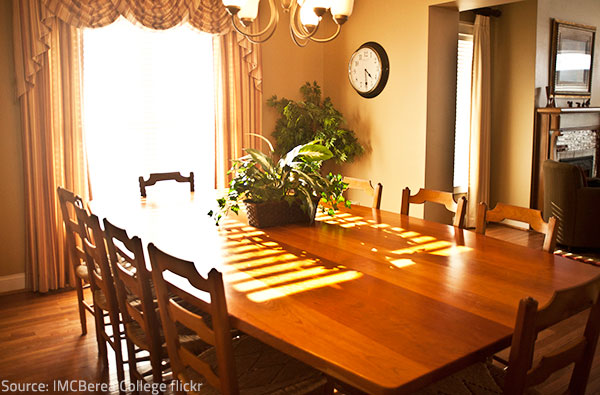
Keep your furniture away from the powerful rays of the sun!
- Use air drapes, UV-blocking shades, blinds and curtains to block the sun when its rays are the strongest. You can even apply a thin screen or film on the windows to prevent UV light from entering the room;
- Keep your furniture away from sources of heat, such as fireplaces, radiators, ovens, boilers, and heating vents;
- Maintain an indoor temperature of 70 to 75 degrees Fahrenheit and a humidity level of 50 to 55 percent to prevent wood from splitting, shrinking, or becoming brittle because of the dry air.
How to Protect Indoor Furniture from Moisture and Mold
Excessive humidity can also have a detrimental effect on your furniture – it may result in mold growth or cause the wood to swell. To prevent moisture damage, you are recommended to:
- Run a home dehumidifier to maintain indoor humidity of about 50 percent;
- Keep your furniture away from sources of moisture – make sure steam from the kitchen or from the bathroom doesn’t reach your furniture, be careful not to spill liquids on the surfaces, etc.;
- Keep your entire home mold-free, as mold spores growing on other surfaces will quickly affect your furniture as well.
Even if your indoor or outdoor furniture has sustained any kind of weather damage, you can still salvage your cherished pieces with the help of professional furniture refinishing and repair services – the experienced specialists will not only efficiently restore your pieces, but will also provide them with the best possible protection for years to come.








